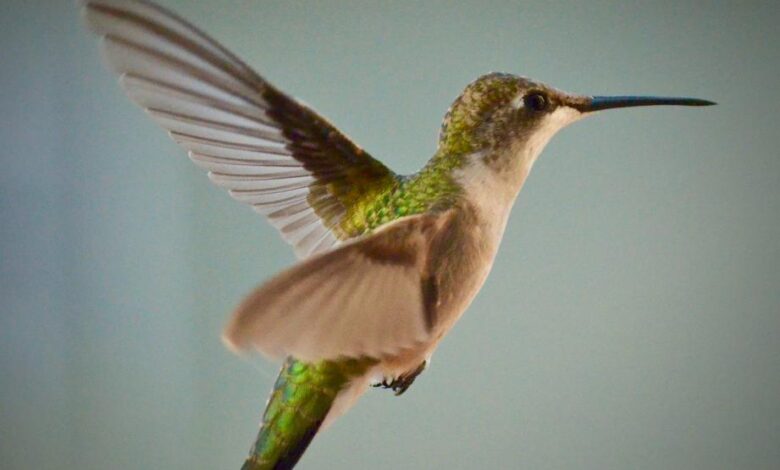
best Hummingbirds Wonderful Pets
Humming birds are wonderful birds that are smart, playful, and easy to take care. Many new bird owners are surprised by the intelligence that many birds show.
They are also very playful. Make sure you do research on all of the different types of birds. Some types of humming birds are more expensive and require more care than do others.
Fortunately, most humming birds require only a little care. If your bird will be alone for most the day, consider buying two birds, so they can keep each other company.
Also, bird toys will help pass the time. Birds have advantages over other pets in that they require only a little space for their cage, will never have trouble with ticks or fleas, and will never cut or scratch anybody.
How to take care of your Humming Birds.
Humming birds require a few basic supplies. The most important is the bird cage. Make sure that your bird cage is large enough for your humming bird to move freely around.
No humming bird will be happy if it always cramped. Also, make sure to buy healthy bird food. Be aware that some types of bird food are made for only certain birds.
If you are unsure of what type of bird food is right for your humming bird, contact your veterinarian. Although humming birds are usually resistant to diseases, they do sometimes become ill.
If you notice that a humming bird is ill, contact your veterinarian immediately. Also, quarantine it from any other humming birds you,
to prevent the spread of the disease. If you take proper care of your humming bird, it will be a friend of yours for years to come.
Learning about Hummingbirds
Hummingbirds are a joy for a birdwatcher to observe. They are found only in the Western Hemisphere, from as far north as Southeastern Alaska and the Maritimes of Canada and as far south as Southern Chile.

There are approximately 350 species of hummingbirds with 320 species found in the tropics. Within the family of hummingbirds is found the smallest bird in the world,
the Bee Hummingbird of Cuba at 2.17 inches (5.5 cm) and weight 1.95gm (0.07 oz). Hummingbirds range in size from 2 inches to 8 inches.
The hummingbird derives its name from the humming sound that is produced by its rapid wingbeat. Generally the wingbeat is so rapid that the individual only sees a blur as most of these birds flap their wings about 50 times per second.
The speed of the wingbeat depends on the size of the bird, the largest the Giant Hummingbird, has a wingbeat rate of 10-15 times per second.
The fastest recorded rate was about 80 times per second, on a tiny Amethyst Woodstar, and the slightly smaller Bee Hummingbird – the world’s smallest bird – may have an even faster rate.
A hummingbird’s wing is flexible at the shoulder, but inflexible at the wrist, this enables them to fly in many different directions.
They can fly right, left, up, down, backwards and even upside down. To move away from the flowers on which they feed hummingbirds fly backwards and are the only bird able to fly backwards.
While other birds get their flight power from the downstroke only, hummingbirds also have strength on the up-stroke. Though they fly very fast, they can suddenly stop and make a soft landing.
They are so light they do not build up much momentum. Hummingbirds have poorly developed feet, so that although they are able to perch and will do so when feeding or resting, they do not walk.
In order to move, even along a branch, they fly. Hummingbirds lift from perches without pushing off; they rise entirely on their own power, flapping their wings at almost full speed before lifting off.
Hummingbirds sleep perched on branches with their neck retracted and their head forward, the bill pointed up at a sharp angle, and the feathers fluffed.
It is believed that hummingbirds live for only 3 to 4 years. They have a fast heartbeat with a rate of 1260 beats per minute having been measured in a Blue-throated Hummingbird. In torpid hummingbirds, the heart rate can drop to 50-180 per minute.
Their fast heart rate and rapid wing motion require them to feed regularly throughout the day. It is reported that they must feed every 10 minutes and they may consume 2/3 of their body weight in a single day.
A major part of a hummingbird’s diet is the nectar they obtain from flowers and their bills are perfectly adapted to the various types of flowers that they feed on.
Some hummingbirds have especially curved or elongated bills that allow them to feed on special flowers, eg the White-tipped Sicklebill hummingbird whose downward curving bill allows it to draw nectar from heliconias.
The Ruby-Topaz Hummingbird has a short and slightly decurved bill that is suited to feeding on the flowers of the ixora shrub. The Blue-tailed Emerald has a short bill that is suited for feeding on the Hibiscus flower.
the Copper-rumped Hummingbird has a straight long bill that allows it to feed on medium sized tube shaped flowers such as the allamanda.
In feeding, hummingbirds use their tongue to lap the nectar in a similar manner to cats lapping milk. Their tongue can extend a distance equal to their beak length.
As they feed hummingbirds accidentally collect pollen and as they move from flower to flower, they help the flowers to reproduce.
Hummingbirds have little or no sense of smell, so colour is important to a hummingbird’s search process for locating flowers containing nectar.
While they will visit any flower that has sufficient nectar they prefer flowers that are red to orange in colour. It is believed that there are several reasons for this colour preference. Red flowers standout in a green background and so are more easily seen by the hummingbird.
It is also believed that because hummingbirds compete with insects for nectar they choose flowers that are less likely to be visited by insects. Most insects do not see well at the red end of the colour spectrum and so may not visit red flowers while hummingbirds see the full visible spectrum.
Hummingbirds also need protein in order to build muscles, so they eat insects. They prefer to feed on small spiders and slow-flying insects such as gnats, small wasps and leafhoppers, which are rather buoyant in air and easy to catch.
They also probe the bark and foliage for insects such as aphids, spiders, caterpillars and insect eggs. It is believed that up to one-half of their diet is made up of small insects. Hummingbirds are capable of living for extended periods without nectar as a component of their diet.
They can quickly convert fat reserves and recently ingested insects to energy when deprived of nectar. Hummingbirds compete for nectar and insects and so they develop territories, which they guard aggressively.
They will fight with other hummingbirds that enter their territory but serious harm is seldom inflicted during these fights. Also when food sources are scarce they fight to protect their source.
Most hummingbirds are green except hermits, which are mainly brown, and are known for the iridescence. These brilliant,
iridescent colors of the hummingbird plumage are caused by the refraction of incident light by the structures of certain feathers. These structures split light into its component colors, and only certain frequencies are refracted back to the viewer.
The brown colour in some hummingbirds is the result however of pigmentation. Hummingbirds groom themselves with their bills and claws, using oil from a gland near their tail. They also use their claws like a comb to groom their heads and necks.
They sunbathe positioning their breast towards the sun and fluffing out, extending their neck and spreading their tail. Hummingbirds also take water baths using the water in shallow pools or cupped leaves.
They flutter their wings or pull them straight back while lifting and spreading their tail; they dip their chins and bellies into the water.
At times they can be seen sitting on a bare branch allowing the rain to soak through to their skin. After bathing they will preen and dry their feathers.
Hummingbirds build cup shaped nests, however hermits build long hanging nests usually attached to foliage. Male hummingbirds do not contribute to the building of nests or the care of young.
All feeding is therefore left to the female. When feeding the female perches on the side of the nest, arches her back, stretches her neck,
lifts her head, and holds her bill down to regurgitate nectar and half-digested insects to her babies. Her throat swells and she pumps her beak like a sewing needle.
Although various larger birds, snakes, and mammals raid hummingbird nests for eggs and chicks, this is not a major cause of death.
Feeding the Hummingbirds
Early in May here in west central Wisconsin, I can count on seeing a Ruby Throated Hummingbird hovering in front of my kitchen window, flitting back and forth, as if to say, “there was a hummingbird feeder RIGHT HERE last year.
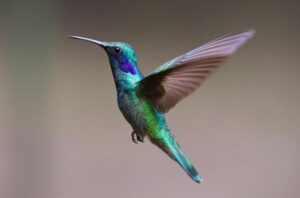
Where is it?”
And then I know it is time to put out hummingbird nectar. I feed a 3-to-1 mixture of water and sugar (3 cups of water and 1 cup of sugar brought to a boil and cooled to room temperature). After the hummingbirds‘ long trip from South America, they are thin and hungry.
The general rule-of-thumb is a 4-to-1 mixture, but to start out in early spring I always use a 3-to-1 mixture. Later on in the summer, when there are more flowers available, I switch to a 4-to-1 mixture.
I know it is important to wash the hummingbird feeder when I fill it to clean out any mold. I know it is also important to thoroughly rinse the hummingbird feeder when I am finished cleaning it to remove any soap or other chemicals.
If the feeder has visible mold, I use a bleach solution (1 teaspoon of bleach to several cups of water) to kill off the mold and mildew.
Then I rinse the feeder thoroughly, under running water, for several minutes with hot water and for several minutes with cold water.
The best hummingbird feeder I’ve found is a Rubbermaid feeder. It holds two cups of nectar, and it is as sturdy now as it was when I bought it four years ago.
Other hummingbird feeders cracked when I tried to wash them, either at the end of the first year or the beginning of the next.
I also set out two of those little “flower balls” for the hummingbirds — little round balls that hold about a quarter cup of nectar with a large, brightly-colored plastic flower that fits down inside the neck.
The flower balls fit into a holder that mounts on a steel rod pushed down into the ground. The hummingbirds love the “flowers” that give them another source of food.
Usually, right around our yard, we have between four and six pair of Ruby Throated Hummingbirds. Later on in the summer, when their offspring start coming for the nectar,
we have many more hummingbirds flying around the yard. Pine trees on the east and north sides of the yard provide a perch for the hummingbirds while they wait their turn to get at the feeder.
Not that the hummingbirds are especially patient about waiting their turn at the feeder. They chase each other around and chatter and scold.
I am scolded, too, when I have the audacity to remove the feeder from its hook in front of the kitchen window so that I can wash it out and fill it with fresh nectar. On more than one occasion, I have ducked to avoid a collision with a hummingbird.
I have learned not to wear a red shirt when taking down the hummingbird feeder during the day. A red shirt causes the hummingbirds to flit back and forth in front of my face, as if searching for the perfect access to this huge, glorious RED flower they see before them.
Instead of filling the hummingbird feeders during the day and risking a collision with the tiny birds, I often wait until after dark to take down the feeder, wash it and fill it with fresh nectar.
That way, when the hummingbirds are looking for food early in the morning, they will find a clean feeder filled with fresh nectar.
As the season progresses, the hummingbirds dramatically increase their nectar consumption so that by July, I am filling the hummingbird feeder at least once per day.
I like having the hummingbird feeder in front of my kitchen window where I can closely observe the hummingbirds as they perch on the feeder and dip their beaks into the nectar.
When the light is just right, I can see their impossibly long tongues darting out to suck up more of the liquid or to lick off the tiny droplet hanging from the end of their beaks.
When the light is just right, it is also easy to see why they are called “Ruby Throated” hummingbirds. The red feathers at the base of the male’s throat glow like the ruby slippers in the Wizard of Oz.
All summer long I watch the hummingbirds, and as September approaches, they became more and more frantic to eat as much as they can, in preparation for the long flight back to South America.
And then, early in September, one day it will dawn on me that I haven’t seen as many hummingbirds. As more days pass, the remaining hummingbirds leave too.
Eventually I don’t see any hummingbirds at all, and I know it will be many months, with a long hard winter in between, before I can once again feed the hummingbirds that hover in front of my kitchen window.
About Hummingbirds and How to Attract Them to Your Garden
Visualize watching a bright green hummingbird in your garden moving from flower to flower in search of the tasty nectar within.

These beautiful and tiny birds weigh about 2 to 20 grams and are found in a wide variety of environments from the high Andes to lowlands, and from dry desert areas to rainforests.
They have slender beaks, extensible tongues, ten primary feathers, and tiny feet suitable for perching but not walking.
Hummingbirds can fly straight up, straight down, backwards, left, right, and even upside down. While most birds obtain their flight strength only from the down stroke, hummingbirds have power on the up stroke as well.
Most hummingbirds flap their wings about fifty times a second and have a very fast heartbeat and high body temperature.
They feed every ten minutes or so throughout the day and typically consume two-thirds of their body weight in a single day. Their source of nutrition is primarily nectar from flowers, as well as sources of protein from insects and tiny spiders.
The key to attracting hummingbirds to your garden mainly consists of the right type of flowers and places where they can perch and rest during the day, such as trees or large plants.
Hummingbirds are guided by visual means and are particularly attracted to certain shades of red. According to The Hummingbird Society, there are several possible explanations for their preference of red blossoms.
Given that insects also see nectar, they can be regarded as competitors. Nearly all insects see well in the visible and near-ultraviolet light but poorly in the red end of the spectrum.
Also, a red blossom may appear nearly black and unattractive to a number of insects, but not to the hummingbird, which can see the full visible spectrum but also some in the ultraviolet. This makes it less likely that an insect has taken nectar from a red flower.
Another likely explanation is that during migration, red blossoms effectively contrast with a green environment more than other colored flowers do.
Hummingbirds are welcomed guests to nearly all gardens. By planting flowering shrubs and plants that are their favored food source, we can easily attract them to become regular visitors to our gardens.
Below is a short list of their preferred flowering plants by common name, separated by region:
Southeastern United States:
Butterfly Bush
Cardinal Flower
Coral or Trumpet Honeysuckle
Cypress Vine
Native Trumpet Creeper
Texas Sage
Southwest United States:
Indian Paintbrush
Lantana
Lily of the Nile
Mexican Honeysuckle
Texas Sage
Western Coral Bean
West Coast United States:
Beebalm
Bottle Brush
Cape Fuchsia
Colombine
Salmonberry
Woodland Orchard
Northeastern United States:
Blue Lobelia
Cardinal Flower
Hollyhock
Red Morning Glory
Salvia
Scarlet Sage
Midwest United States:
Coral Bells
Coral Honeysuckle
Foxglove
Hosta
Impatients
Lilac
Even though flowers are the natural means to attract hummingbirds to your garden, man-made feeders filled with a mixture of water and sugar (sucrose) are an essential alternative. Sugar, whether from a flower or a feeder, is a necessary nutrient in a hummingbird’s diet.
Tests have shown that hummingbirds favor sucrose in flower nectar more than other sugars such as fructose and glucose.
Therefore, with the proper ratio of ingredients, your feeder becomes a good substitute to the flowers that hummingbirds like best.
The formula for the mixture used in hummingbird feeders is 4 parts water (not distilled) to 1 part table sugar. Boil the mixture for one to two minutes, then cool and store in refrigerator.
The mixture can be stored in the refrigerator for up to one week. Do not use red food coloring, honey, or artificial sweeteners in your mixture, as this could be harmful to the hummingbirds.
If one of your goals is to attract hummingbirds to your garden, a visit to your local nursery is a great starting point.
Find an experienced employee who can tell you which species of plants grow well in your area and have a history of successfully attracting hummingbirds. Most importantly, be imaginative and have fun planting and growing your garden to attract beautiful hummingbirds.
best 1 hummingbird feeder,first nature hummingbird feeder,walmart hummingbird feeder,hummingbird feeders amazon,large hummingbird feeder,consumer reports best hummingbird feeder,can you buy a hummingbird as a petbest hummingbird feeders amazon,
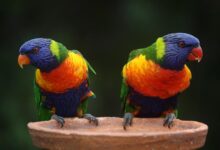
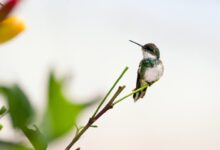
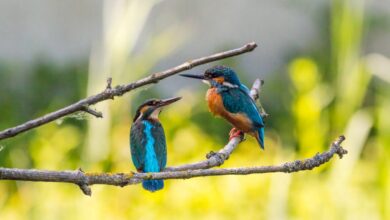

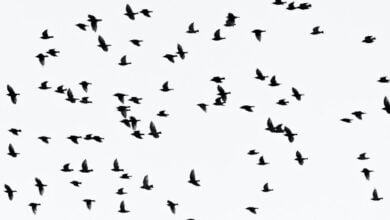
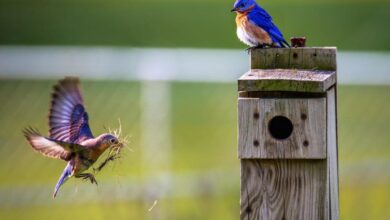
At the beginning, I was still puzzled. Since I read your article, I have been very impressed. It has provided a lot of innovative ideas for my thesis related to gate.io. Thank u. But I still have some doubts, can you help me? Thanks.